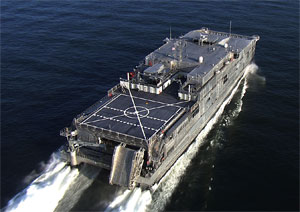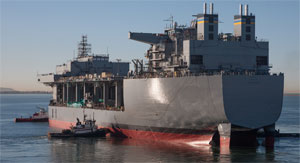There is growing bipartisan agreement in Washington on what U.S. shipbuilders have been saying for years: Across-the-board budget cuts, better known as sequestration, are a bad way to do business. Long-term planning leads to savings on procurement and production, but without a commitment under the budget ax — essentially reducing military shipbuilding to a “one off” or “two off” enterprise — everyone loses in the end.
The realization hasn’t changed the approach, however. As American Ship Review went to press, Congress had yet to take action to stave off the next round of 10 percent cuts, something that lawmakers rallied to do for two years with the Bipartisan Budget Act of 2013. Tens of billions of dollars in new defense rollbacks now loom and were scheduled to start biting Oct. 1, the start of fiscal year 2016.
Matt Paxton, president of the Shipbuilders Council of America (SCA), was cautiously optimistic in August that lawmakers were “going to figure this out” and prevent the mandatory cuts from taking effect.
“It’s a whack on every defense asset we build,” Paxton said. “It’s completely chaotic and it’s completely problematic when you’re trying to build these vessels. Sequestration is just a really bad way to operate. You can’t plan, and that’s one of the things that our Navy shipbuilders do incredibly well. They plan these programs, they meet time frames and they deliver.”
Paxton said the SCA has worked very closely with the Navy League to raise awareness in Congress about the importance of military shipbuilding and why it needs to be funded. In July, the SCA launched Know Your Ship, a national campaign to promote the industry and call attention to the critical role it plays in maintaining America’s national and economic security.
 |
|
USNS Fall River (JHSV 4) underway. |
|
Courtesy Austal USA |
“It really tells the story that when you build an LCS, when you build an aircraft carrier, when you build a tanker up at Aker, that ship just isn’t built right there in Philadelphia,” he said. “It impacts jobs across the nation. Shipbuilding truly is a manufacturing sector that hits all 50 states. So when we build these assets, while there’s definitely a benefit to that local community that has the shipyard, there’s also a multiplier effect that trickles through our entire economy.”
According to a recent report from the U.S. Maritime Administration (MarAd), each job in the shipbuilding and repair industry leads to another 2.7 jobs nationally. For every dollar spent on goods and services in the sector, another $2.66 is spent in the wider economy.
Offshore patrol cutters: Who gets the newbuilds?
Outside of sequestration, the pending construction award for the U.S. Coast Guard’s new offshore patrol cutter (OPC) was probably the hottest topic of the past year for military shipbuilders.
In early 2014, Bollinger Shipyards, Eastern Shipbuilding Group and Bath Iron Works each received a $21.9 million design contract for the project, which calls for 25 ships to be built at a cost of $10 billion. The new OPCs will replace the 210-foot and 270-foot medium endurance cutters that the Coast Guard uses for security operations, drug interdictions and search-and-rescue missions.
The decision on which of the three yards gets the megadeal is expected in early 2016. The Coast Guard expects steel to be cut on the first new cutter in fiscal 2018.
 |
|
The national security cutter James performs during builder’s trials in March in the Gulf of Mexico. |
|
Courtesy Huntington Ingalls Industries |
“I know everyone, the Coast Guard and the shipyards, is eager to see the OPC program get started,” Paxton said. “I think the national security cutter (NSC) program has been a wonderful example of great shipbuilding. Ingalls has done a great job with that program and I know the Coast Guard is very happy with it. I know people are eager to see what happens with the OPC.”
Warming up to icebreakers
The campaign for additional Coast Guard icebreaking assets, a long-neglected part of the service’s fleet, got a boost in early September from a prominent voice: President Obama.
During a visit to Alaska to highlight the consequences of climate change, Obama called for speeding the acquisition and construction of new Coast Guard icebreakers for the Arctic, in part to counter Russia’s growing influence in the region. The administration said the Coast Guard has just two “fully functional” icebreakers at its disposal, down from seven during World War II. Russia has 40 icebreakers and another 11 planned or under construction.
The 399-foot Polar Star is the only heavy icebreaker currently on duty for the Coast Guard. Its sister ship, Polar Sea, has been out of service since 2010 due to engine failure and is in “inactive commission” in Seattle, according to the Coast Guard’s webpage for the ship. The 420-foot Healy, which in September became the first U.S. surface ship to reach the North Pole unaccompanied, is used primarily for research and is classified as a medium icebreaker by the Coast Guard.
Obama wants to accelerate the acquisition of a new heavy polar icebreaker by two years, from 2022 to 2020; begin planning for the construction of additional icebreakers; and ask Congress to authorize “sufficient resources” to pay for them.
 |
|
USNS Lewis B. Puller is the third mobile landing platform from General Dynamics NASSCO and the first to be configured as a forward staging base. |
|
Courtesy General Dynamics NASSCO |
“The growth of human activity in the Arctic region will require highly engaged stewardship to maintain the open seas necessary for global commerce and scientific research, allow for search-and-rescue activities and provide for regional peace and stability,” the White House said in a prepared statement.
Such stewardship won’t come cheaply. The cost of developing and building a new heavy icebreaker is expected to be $1 billion, an amount equivalent to the entire acquisitions budget of the Coast Guard for fiscal 2015.
Beyond budget talk and proposals for fleet upgrades, a number of military newbuilds hit the water in the past year. Here is a look at some of the activity at U.S. yards and one in Canada:
General Dynamics NASSCO
The San Diego shipbuilder delivered USNS Lewis B. Puller, the third mobile landing platform for the U.S. Navy’s Military Sealift Command.
The 785-foot MLP is configured as an afloat forward staging base (AFSB), giving it a different look from its predecessors. The modifications include a 52,000-square-foot flight deck, fuel and equipment storage, mission planning spaces and accommodations for up to 250 personnel.
 |
|
Isaac Mayo is the 12th Sentinel-class fast response cutter (FRC) from Bollinger Shipyards. |
|
Courtesy Bollinger Shipyards |
The Navy awarded NASSCO a contract for the detail design and construction of a fourth ship in the series that also will be configured as an AFSB. Construction was set to begin in the fourth quarter of 2015.
Bollinger Shipyards
The company made its biggest splash when it announced that it had been acquired by Chief Operating Officer Ben Bordelon and the owners of Edison Chouest Offshore, with Bordelon assuming the duties of president and chief executive officer. But the shipbuilder also stayed in the news by delivering four more fast response cutters (FRCs) to the Coast Guard.
William Trump, Isaac Mayo, Richard Dixon and Heriberto Hernandez are the 11th, 12th, 13th and 14th cutters, respectively, in the Sentinel-class program. The Lockport, La.-based company has contracts for 30 FRCs in a package valued at $1.4 billion.
Bollinger faced new legal pressure in December when the U.S. 5th Circuit Court of Appeals reversed the dismissal of a $78 million lawsuit filed against the company by the U.S. government. The suit alleges that Bollinger lied about the hull strength of eight patrol boats lengthened for the Coast Guard. The vessels were deemed unseaworthy after a boat’s hull began to buckle at sea.
Austal USA
The Mobile, Ala., shipbuilder delivered two more joint high speed vessels (JHSVs) to the U.S. Navy and launched another. USNS Fall River and USNS Trenton, the fourth and fifth ships in the Spearhead class, were followed into the water by USNS Brunswick, which was slated for delivery in late 2015. The yard is under contract to build 10 of the 338-foot JHSVs in a $1.6 billion deal.
 |
|
Austal USA delivered the littoral combat ship USS Jackson, below, to the Navy in August. |
|
Courtesy Austal USA |
In August, Austal delivered USS Jackson (LCS 6), the first Independence-variant littoral combat ship built by the yard as prime contractor. In June, the yard christened USS Gabrielle Giffords (LCS 10) and laid the keel for the future USS Manchester (LCS 14). The 419-foot trimarans are part of a 10-vessel, $3.5 billion block buy.
Marinette Marine
The Wisconsin company launched a pair of Freedom-variant littoral combat ships, USS Detroit (LCS 7) and USS Little Rock (LCS 9), and laid the keel for another, USS Wichita (LCS 13). The Marinette yard also received funding from the Navy to build one more LCS in 2015.
The Freedom and Independence variants are produced by industry teams led by Lockheed Martin (partnering with Marinette Marine) and General Dynamics (partnering with Austal USA).
Huntington Ingalls
Ingalls Shipbuilding in Pascagoula, Miss., delivered the national security cutter James to the Coast Guard in June. The fifth Legend-class NSC was commissioned in Boston in August and is home-ported in Charleston, S.C.
The 418-foot NSCs are replacing the Coast Guard’s Hamilton-class cutters that were introduced in the 1960s. Two more NSCs, Munro and Kimball, are under construction at the Mississippi yard. Ingalls was awarded a contract for an eighth NSC, Midgett, in March 2015.
 |
|
Ingalls Shipbuilding worker Paul Bosarge fabricates steel for the national security cutter Kimball using an Avenger 3 plasma cutter. The ship is scheduled for delivery in 2018. |
|
Courtesy Huntington Ingalls Industries |
Ingalls also christened the company’s 10th amphibious transport dock, John P. Murtha (LPD 26), in March. The 684-foot ships are used to deploy Marines and their equipment via air-cushion or conventional landing craft and amphibious assault vehicles. Portland (LPD 27), is scheduled to launch in 2016.
Irving Shipbuilding
Irving made history in September, cutting steel on the first warship to be built under Canada’s $35 billion National Shipbuilding Procurement Strategy. The Arctic patrol ship, HMCS Harry DeWolf, is named after one of Canada’s most distinguished sailors in World War II.
The 340-foot vessel is the first in a series of six from the Halifax shipyard under a $2.3 billion build contract with the Royal Canadian Navy. Delivery is expected in 2018.
Irving delivered a new midshore patrol ship, CCGS A. LeBlanc, to the Canadian Coast Guard in July. The 140-foot Hero-class vessel will be used primarily to enforce fisheries regulations in the St. Lawrence River and Gulf of St. Lawrence.

